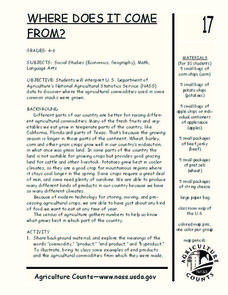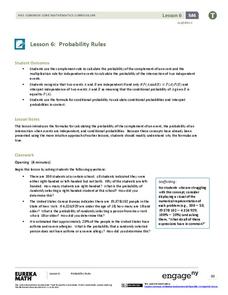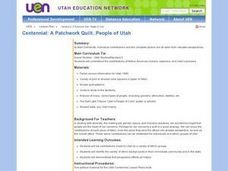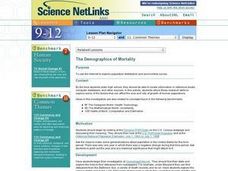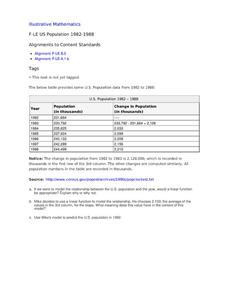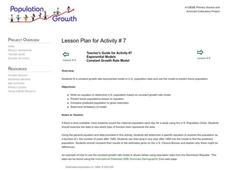Curated OER
Separate But Equal? A Lesson on the Briggs v. Elliott Case in Claredon County, SC
Third graders discussschool integration. In this racial inequality instructional activity, 3rd graders read Remember: The Journey to School Integrationand discuss the school facilities and how people must have felt. Students watch a...
Curated OER
"Maple Leaf Rag" by Scott Joplin
In this classical music appreciation worksheet, students listen to a recording of "Maple Leaf Rag" by Scott Joplin. Students read about the composer and the structure of the piece. Students answer 5 questions and then complete a word...
Curated OER
Where Does It Come from?
Students read articles about various agricultural products and create a map using the statistics in the article. In this agricultural statistics lesson, students look at the geography of the country and which products come from the...
DocsTeach
Exploring America's Diversity: Gertrud Danneberg (Beginner)
Everyone is an immigrant in their own way. Young scholars read historic documents to understand one woman's journey from Germany to the United States. The activity uses a mixture of text, discussion, and written prompts to help...
EngageNY
Probability Rules (part 1)
In statistics, probability rules—literally! Learners use their previous knowledge and explore a set of rules for conditional probability, independent probability, and complements. Given different scenarios, they must determine what type...
Curated OER
The People of Kansas: Where Did They Come From and Why Did They Come?
Students research and discuss the reasons why early settlers emigrated to Kansas. They, in groups, analyze census district reports from the 1850's and then identify the advantages and disadvantages of using this information as research.
Curated OER
Look, There's Another One!
In this math worksheet, students spend a week collecting information on either the word or U.S. populations from the U.S. Census Bureau Web site. Students record their data in a chart and bar graph. Students also use the website to...
Curated OER
An Act of Courage, The Arrest Records of Rosa Parks
Students research accounts on Rosa Parks and look for differences between the modern form and an older report on Parks. They discuss why information about race and nationality are collected on these and other forms.
Curated OER
Pop Clock
Students review the Census Bureau's Homepage, gather information regarding population trends in order to make predictions on future populations.
Curated OER
Germans and Irish in Augusta and Franklin Counties
Students examine 19th century newspapers, a last and testament, and census manuscripts to analyze the Irish and German immigrant communities in the 1850s and 1860s. They write a letter from the perspective of an Irish or German immigrant.
Curated OER
Population Growth and Urban Planning
Students discuss the following terms and their definitions: zero population growth, population density, demographics, urban sprawl, census, immigration, migration, infrastructure, population booms, megacities, birthrate, death rate,...
Curated OER
Jobs in Jamestown
Students research data on Jamestown settlers in order to learn about the daily life and events in the colony. In this investigative history lesson, students work in groups to analyze the results of the Jamestown census. Students take...
Curated OER
Centennial: A Patchwork Quilt of the People of Utah
Students discuss the many cultures of the people of Utah. They create a database of the family backgrounds of students in the class. They record the major contributions of each ethnic group and display them on a quilt.
NYC Department of Records
Citizenship and Elections: The Importance of a Ballot
Approximately 58 prcent of those eligible voted in the 2016 US Presidential election. In an attempt to impress upon learners the importance of voting and voting rights, class members examine primary source documents related to the...
Curated OER
What Birds Are Flying Around Your Schoolyard?
Learners conduct a long-term census for the birds that are seen or heard around their schoolyard. They practice identifying birds using field guides and then count and record the birds in fifteen minute sessions every other day for four...
Curated OER
Patterns of Settlement in Early Alabama
Fourth graders study the settlement of Alabama. They collect data from the U.S. census website and answer questions regarding settlement patterns in the counties of Alabama in 1820. They write a paagraph describing where they would have...
Curated OER
Pop Clock
Young scholars explore the Census Bureau's Homepage on the Internet to gather data regarding trends in population, poverty guidelines, and social characteristics between caucasians and minorities. The data is used to investigate evidence...
Curated OER
The Demographics of Mortality
Students view the Dynamic POPClocks on the U.S. Census webpage and discuss their meaning. They explore age-related death rates of the human population and collect information about the deaths of humans and organize them into a life table.
Curated OER
Popular Sovereignty Under the Kansas-Nebraska Act
Seventh graders examine the implications of the Kansas-Nebraska Act. In this slavery lesson, 7th graders examine a map of 1820 America and discuss the balance of power implied by the map. Students then read Stephen Douglas's speech on...
Curated OER
Race and Crime in the United States: Are We Victims of Discrimination or Antiheroes?
Using methods adopted by Public Policy Analysts (PPA) class groups define a social problem, gather evidence to document the existence of the problem, identify causes, evaluate existing policies designed to deal with the problem, develop...
Curated OER
Becoming a Member of an 1830s Family
Students compare and constrast life in an 1830s family verses a modern family. They role play the position of a family member in 1830 while wearing traditional clothing for the time period. They write journal entries to show their daily...
Curated OER
US Population 1982-1988
Your algebra learners make predictions using the concepts of a linear model from real-life data given in table form. Learners analyze and discuss solutions without having to write a linear equation.
Curated OER
Exponential Models
Students fit a constant growth rate exponential model to U.S. population data and use the model to predict future population. They write an equation to determine U.S. population based on constant growth rate model.
National Endowment for the Humanities
Lost Hero: Was John Hanson Actually the First President?
The first president of the United States was ... John Hanson? Scholars investigate the notion that the initial leader of the nation was not George Washington. Using research, articles, and open discussion, individuals create a quest for...




